Effects of Two-Phase Flow of Water and Air on Shallow Slope Failures Induced by Rainfall: Insights from Slope Stability Assessment at a Regional Scale
Abstract
:1. Introduction
2. Materials and Methods
2.1. Study Area
2.2. Data
2.2.1. Landslide Inventories and Spatial Data
2.2.2. Material Properties
2.3. Methods
2.3.1. Rainfall Infiltration Analysis
2.3.2. Slope Stability Analysis
2.3.3. Slope Geometry and Boundary/Initial Conditions
2.3.4. Performance Evaluation of Slope Stability Assessment
3. Results and Discussion
3.1. Validation with Comparison to Field Measurements
3.2. Infiltration Analysis
3.3. Slope Stability Assessment
4. Conclusions
- Considering that air flow changes the rate of increase in Pw on slopes with a low infiltration capacity when ponding occurs during heavy rainfall, and that the saturated hydraulic conductivity is relatively marginal in the mountainous areas of Korea (i.e., less than 2.78 × 10−5 m/s according to the National Disaster Management Institute [57]), it is necessary to apply the two-phase flow model to accurately interpret rainfall infiltration.
- The initial safety factor prior to rainfall depends on the shear strength parameters (i.e., internal friction angle and cohesion); however, variations in the safety factor are strongly dependent on an increase in the Pw rate. Slopes in the single-phase flow model rapidly become saturated during heavy rainfall because of the high rainfall infiltration rates without the interruption of air. Thus, safety factors decrease rapidly compared to those in the two-phase flow model.
- Landslide susceptibility maps change depending on an increase in Pw, which depends on relative permeability. It is also sensitive to the model type. The MSR and confusion matrix yield the highest performance for the two-phase flow model with an appropriate range of stable cell coverage for the best simulation. Thus, it is concluded that infiltration and slope stability analyses using the two-phase flow model have good applicability in evaluating landslide events in Umyeon Mountain. However, it is necessary to additionally evaluate the applicability of this model for other landslide cases.
- We performed infiltration and slope stability analyses focusing on the geotechnical characteristics of unsaturated soils in the upper layer. Besides, we excluded geological characteristics given that most of the slope failure in the study area occurred at the colluvium layer with shallow depths up to 2 m. The two-phase flow model can be usefully applied to the region where shallow slope failure occurs primarily. However, further study is required to examine the effects of the geological structure for improving the applicability of the two-phase flow model to the region where deep slope failure occurs primarily, which is affected not only by geotechnical characteristics but also by geological structure.
- The performance of slope stability assessments at a regional scale is greatly affected by the uncertainty and variability of geotechnical and hydrological input parameters when physically based models are applied. Geotechnical and hydrological properties have probabilistically or statistically been characterized based on types of soil and lithology to properly consider the uncertainty and variability of them [58,59], whereas we used representative constant soil properties at each of the five zones as averaged from field measurements. The applicability of the two-phase flow model to a regional scale can be improved by further study applying the probabilistic approach for characterizing the uncertainty and variability of geotechnical and hydrological input parameters.
Author Contributions
Funding
Acknowledgments
Conflicts of Interest
References
- Chen, H.-E.; Tsai, T.-L.; Yang, J.-C. Threshold of Slope Instability Induced by Rainfall and Lateral Flow. Water 2017, 9, 722. [Google Scholar] [CrossRef] [Green Version]
- Haque, U.; da Silva, P.F.; Devoli, G.; Pilz, J.; Zhao, B.; Khaloua, A.; Wilopo, W.; Andersen, P.; Lu, P.; Lee, J.; et al. The human cost of global warming: Deadly landslides and their triggers (1995–2014). Sci. Total Environ. 2019, 682, 673–684. [Google Scholar] [CrossRef] [PubMed]
- Cho, S.E. Study on the characteristics of infinite slope failures by probabilistic seepage analysis. J. Korean Geotech. Soc. 2014, 30, 5–18. [Google Scholar] [CrossRef] [Green Version]
- McGuire, L.A.; Rengers, F.K.; Kean, J.W.; Coe, J.A.; Mirus, B.B.; Baum, R.L.; Godt, J.W. Elucidating the role of vegetation in the initiation of rainfall-induced shallow landslides: Insights from an extreme rainfall event in the Colorado Front Range. Geophys. Res. Lett. 2016, 43, 9084–9092. [Google Scholar] [CrossRef] [Green Version]
- Johnson, J.M.; Loáiciga, H.A. Coupled Infiltration and Kinematic-Wave Runoff Simulation in Slopes: Implications for Slope Stability. Water 2017, 9, 327. [Google Scholar] [CrossRef] [Green Version]
- Ehlers, W.; Avci, O.; Markert, B. Computation of Slope Movements Initiated by Rain–Induced Shear Bands in Small–Scale Tests and In Situ. Vadose Zone J. 2011, 10, 512–525. [Google Scholar] [CrossRef]
- Germer, K.; Braun, J. Effects of Saturation on Slope Stability: Laboratory Experiments Utilizing External Load. Vadose Zone J. 2011, 10, 477–486. [Google Scholar] [CrossRef]
- Wienhöfer, J.; Lindenmaier, F.; Zehe, E. Challenges in Understanding the Hydrologic Controls on the Mobility of Slow-Moving Landslides. Vadose Zone J. 2011, 10, 496–511. [Google Scholar] [CrossRef]
- Cho, S.E.; Lee, S.R. Instability of unsaturated soil slopes due to infiltration. Comput. Geotech. 2001, 28, 185–208. [Google Scholar] [CrossRef]
- Ng, C.W.W.; Shi, Q. A numerical investigation of the stability of unsaturated soil slopes subjected to transient seepage. Comput. Geotech. 1998, 22, 1–28. [Google Scholar] [CrossRef]
- Cho, S.E. Stability analysis of unsaturated soil slopes considering water–air flow caused by rainfall infiltration. Eng. Geol. 2016, 211, 184–197. [Google Scholar] [CrossRef]
- Yeh, H.F.; Lee, C.H.; Lee, C.C. A rainfall–infiltration model for unsaturated soil slope stability. Sustain. Environ. Res. 2008, 18, 271–278. [Google Scholar]
- Thomas, M.A.; Mirus, B.B.; Collins, B.D. Identifying Physics-Based Thresholds for Rainfall-Induced Landsliding. Geophys. Res. Lett. 2018, 45, 9651–9661. [Google Scholar] [CrossRef]
- Richards, L.A. Capillary conduction of liquids through porous mediums. Physics 1931, 1, 318–333. [Google Scholar] [CrossRef]
- Jeong, S.; Lee, K.; Kim, J.; Kim, Y. Analysis of Rainfall-Induced Landslide on Unsaturated Soil Slopes. Sustainability 2017, 9, 1280. [Google Scholar] [CrossRef] [Green Version]
- Tran, T.V.; Lee, G.; An, H.; Kim, M. Comparing the performance of TRIGRS and TiVaSS in spatial and temporal prediction of rainfall-induced shallow landslides. Environ. Earth Sci. 2017, 76, 315. [Google Scholar] [CrossRef]
- Borja, R.I.; White, J.A. Continuum deformation and stability analyses of a steep hillside slope under rainfall infiltration. Acta Geotech. 2010, 5, 1–14. [Google Scholar] [CrossRef]
- Borja, R.I.; White, J.A.; Liu, X.; Wu, W. Factor of safety in a partially saturated slope inferred from hydro–mechanical continuum modeling. Int. J. Numer. Anal. Methods Geomech. 2012, 36, 236–248. [Google Scholar] [CrossRef] [Green Version]
- Hu, R.; Hong, J.-M.; Chen, Y.-F.; Zhou, C.-B. Hydraulic hysteresis effects on the coupled flow–deformation processes in unsaturated soils: Numerical formulation and slope stability analysis. Appl. Math. Model. 2018, 54, 221–245. [Google Scholar] [CrossRef]
- Liu, G.; Tong, F.-G.; Zhao, Y.-T.; Tian, B. A force transfer mechanism for triggering landslides during rainfall infiltration. J. Mt. Sci. 2018, 15, 2480–2491. [Google Scholar] [CrossRef]
- Sun, D.M.; Zang, Y.G.; Semprich, S. Effects of airflow induced by rainfall infiltration on unsaturated soil slope stability. Transp. Porous Media 2015, 107, 821–841. [Google Scholar] [CrossRef]
- Wu, L.Z.; Zhang, L.M.; Zhou, Y.; Li, B.E. Analysis of multi-phase coupled seepage and stability in anisotropic slopes under rainfall condition. Environ. Earth Sci. 2017, 76, 469. [Google Scholar] [CrossRef]
- Zhang, X.Y.; Zhu, Y.M.; Fang, C.H. The role for air flow in soil slope stability analysis. J. Hydrodyn. 2009, 21, 640–646. [Google Scholar] [CrossRef]
- Chen, P.; Mirus, B.; Lu, N.; Godt, J.W. Effect of Hydraulic Hysteresis on Stability of Infinite Slopes under Steady Infiltration. J. Geotech. Geoenviron. Eng. 2017, 143, 04017041. [Google Scholar] [CrossRef] [Green Version]
- Ebel, B.A.; Loague, K.; Borja, R.I. The impacts of hysteresis on variably saturated hydrologic response and slope failure. Environ. Earth Sci. 2010, 61, 1215–1225. [Google Scholar] [CrossRef]
- Simoni, S.; Zanotti, F.; Bertoldi, G.; Rigon, R. Modelling the probability of occurrence of shallow landslides and channelized debris flows using GEOtop-FS. Hydrol. Process. 2008, 22, 532–545. [Google Scholar] [CrossRef]
- Rigon, R.; Bertoldi, G.; Over, T.M. GEOtop: A Distributed Hydrological Model with Coupled Water and Energy Budgets. J. Hydrometeorol. 2006, 7, 371–388. [Google Scholar] [CrossRef]
- Chen, L.-K.; Chang, C.-H.; Liu, C.-H.; Ho, J.-Y. Application of a Three-Dimensional Deterministic Model to Assess Potential Landslides, a Case Study: Antong Hot Spring Area in Hualien, Taiwan. Water 2020, 12, 480. [Google Scholar] [CrossRef] [Green Version]
- Reid, M.E.; Christian, S.B.; Brien, D.L.; Henderson, S.T. Scoops3D—Software to Analyze Three-Dimensional Slope Stability Throughout a Digital Landscape (Version 1.0); U.S. Geological Survey: Reston, VA, USA, 2015.
- Park, D.W.; Lee, S.R.; Vasu, N.N.; Kang, S.H.; Park, J.Y. Coupled model for simulation of landslides and debris flows at local scale. Nat. Hazards 2016, 81, 1653–1682. [Google Scholar] [CrossRef]
- Tran, T.V.; Alvioli, M.; Lee, G.; An, H.U. Three-dimensional, time-dependent modeling of rainfall-induced landslides over a digital landscape: A case study. Landslides 2018, 15, 1071–1084. [Google Scholar] [CrossRef]
- GEO-SLOPE International. User’s Manual: SEEP/W and SLOPE/W; Geo-Slope International Ltd.: Calgary, AB, Canada, 2012. [Google Scholar]
- Baum, R.L.; Savage, W.Z.; Godt, J.W. TRIGRS—A Fortran Program for Transient Rainfall Infiltration and Grid-based Regional Slope-stability Analysis, Version 2.0; US Geological Survey Open-File Report 2008-1159; US Geological Survey: Reston, VA, USA, 2008; p. 75.
- An, H.; Viet, T.T.; Lee, G.; Kim, Y.; Kim, M.; Noh, S.; Noh, J. Development of time-variant landslide-prediction software considering three-dimensional subsurface unsaturated flow. Environ. Model. Softw. 2016, 85, 172–183. [Google Scholar] [CrossRef]
- Dong, H.; Huang, R.; Gao, Q.-F. Rainfall infiltration performance and its relation to mesoscopic structural properties of a gravelly soil slope. Eng. Geol. 2017, 230, 1–10. [Google Scholar] [CrossRef]
- Touma, J.; Vauclin, M. Experimental and Numerical Analysis of Two Phase Infiltration in a Partially Saturated Soil. Transp. Porous Media 1986, 1, 27–55. [Google Scholar] [CrossRef]
- National Geographic Information Institute of Korea. Available online: http://map.ngii.go.kr/mn/mainPage.do (accessed on 15 August 2019).
- Kang, S.; Lee, S.-R. Debris flow susceptibility assessment based on an empirical approach in the central region of South Korea. Geomorphology 2018, 308, 1–12. [Google Scholar] [CrossRef]
- Kang, S.; Lee, S.-R.; Vasu, N.N.; Park, J.-Y.; Lee, D.-H. Development of an initiation criterion for debris flows based on local topographic properties and applicability assessment at a regional scale. Eng. Geol. 2017, 230, 64–76. [Google Scholar] [CrossRef]
- Korea Meteorological Administration. Available online: http://www.weather.go.kr/weather/observation/aws_table_popup.jsp (accessed on 7 March 2019).
- Seoul Metropolitan Government. Causes Survey and Restoration Work of Mt. Umyeon Landslides; Seoul Metropolitan Government: Seoul, Korea, 2014; p. 435.
- Korean Geotechnical Society. Research Contract Report: Addition and Complement Causes Survey of Mt. Umyeon Landslides; Society, K.G., Ed.; Korean Geotechnical Society: Seoul, Korea, 2011; p. 268. [Google Scholar]
- van Genuchten, M.T. A closed-form equation for predicting the hydraulic conductivity of unsaturated soils. Soil Sci. Soc. Am. J. 1980, 44, 892–898. [Google Scholar] [CrossRef] [Green Version]
- Fredlund, D.G.; Rahardjo, H. Soil Mechanics for Unsaturated Soils; John Wiley & Sons, Inc.: Hoboken, NJ, USA, 1993. [Google Scholar]
- Korea Institue of Geoscience and Mineral Resources. Available online: https://mgeo.kigam.re.kr/ (accessed on 3 March 2020).
- Itasca. User’s Manual: Fluid–Mechanical Interaction, FLAC 7.0; Itasca Consulting Group, Inc.: Minneapolis, MN, USA, 2011. [Google Scholar]
- Mualem, Y. A new model for predicting the hydraulic conductivity of unsaturated porous media. Water Resour. Res. 1976, 12, 513–522. [Google Scholar] [CrossRef] [Green Version]
- Lenhard, R.J.; Parker, J.C. A model for hysteretic constitutive relations governing multiphase flow: 2. Permeability-saturation relations. Water Resour. Res. 1987, 23, 2197–2206. [Google Scholar] [CrossRef]
- Bishop, A.W. The principle of effective stress. Teknisk Ukeblad 1959, 106, 859–863. [Google Scholar]
- Chateau, X.; Dormieux, L. Micromechanics of Unsaturated Porous Media. In IUTAM Symposium on Theoretical and Numerical Methods in Continuum Mechanics of Porous Materials; Solid Mechanics and Its Applications, Vol 87; Ehlers, W., Ed.; Springer: Berlin/Heidelberg, Germany, 2001; pp. 125–130. [Google Scholar]
- Chateau, X.; Dormieux, L. Micromechanics of saturated and unsaturated porous media. Int. J. Numer. Anal. Methods Geomech. 2002, 26, 831–844. [Google Scholar] [CrossRef]
- Zhang, L.; Wu, F.; Zheng, Y.; Chen, L.; Zhang, J.; Li, X. Probabilistic calibration of a coupled hydro-mechanical slope stability model with integration of multiple observations. Georisk Assess. Manag. Risk Eng. Syst. Geohazards 2018, 12, 169–182. [Google Scholar] [CrossRef]
- Kim, J.; Jeong, S.; Park, S.; Sharma, J. Influence of rainfall-induced wetting on the stability of slopes in weathered soils. Eng. Geol. 2004, 75, 251–262. [Google Scholar] [CrossRef]
- Beguería, S. Validation and Evaluation of Predictive Models in Hazard Assessment and Risk Management. Nat. Hazards 2006, 37, 315–329. [Google Scholar] [CrossRef] [Green Version]
- Huang, J.C.; Kao, S.J. Optimal estimator for assessing landslide model performance. Hydrol. Earth Syst. Sci. 2006, 10, 957–965. [Google Scholar] [CrossRef] [Green Version]
- Hu, R.; Chen, Y.; Zhou, C. Modeling of coupled deformation, water flow and gas transport in soil slopes subjected to rain infiltration. Sci. China Technol. Sci. 2011, 54, 2561. [Google Scholar] [CrossRef]
- National Disaster Management Institute. Study on the Secure Plan for the Stability of Slope Based on Ground Characteristics; Report no.: 11-1311526-000053-01; National Disaster Management Institute: Seoul, Korea, 2012; p. 138.
- Salciarini, D.; Fanelli, G.; Tamagnini, C. A probabilistic model for rainfall–induced shallow landslide prediction at the regional scale. Landslides 2017, 14, 1731–1746. [Google Scholar] [CrossRef]
- Tofani, V.; Bicocchi, G.; Rossi, G.; Segoni, S.; D’Ambrosio, M.; Casagli, N.; Catani, F. Soil characterization for shallow landslides modeling: A case study in the Northern Apennines (Central Italy). Landslides 2017, 14, 755–770. [Google Scholar] [CrossRef] [Green Version]
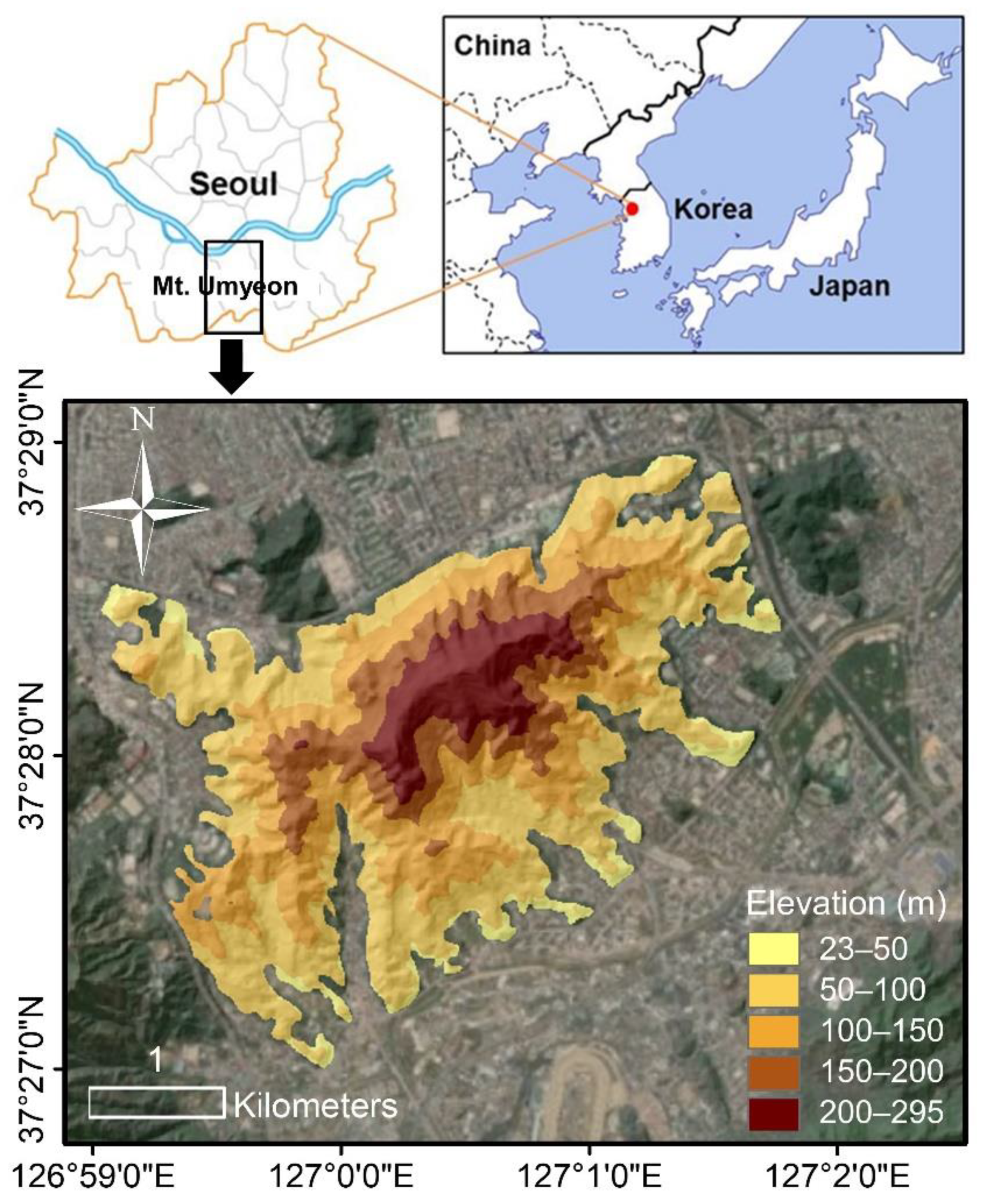
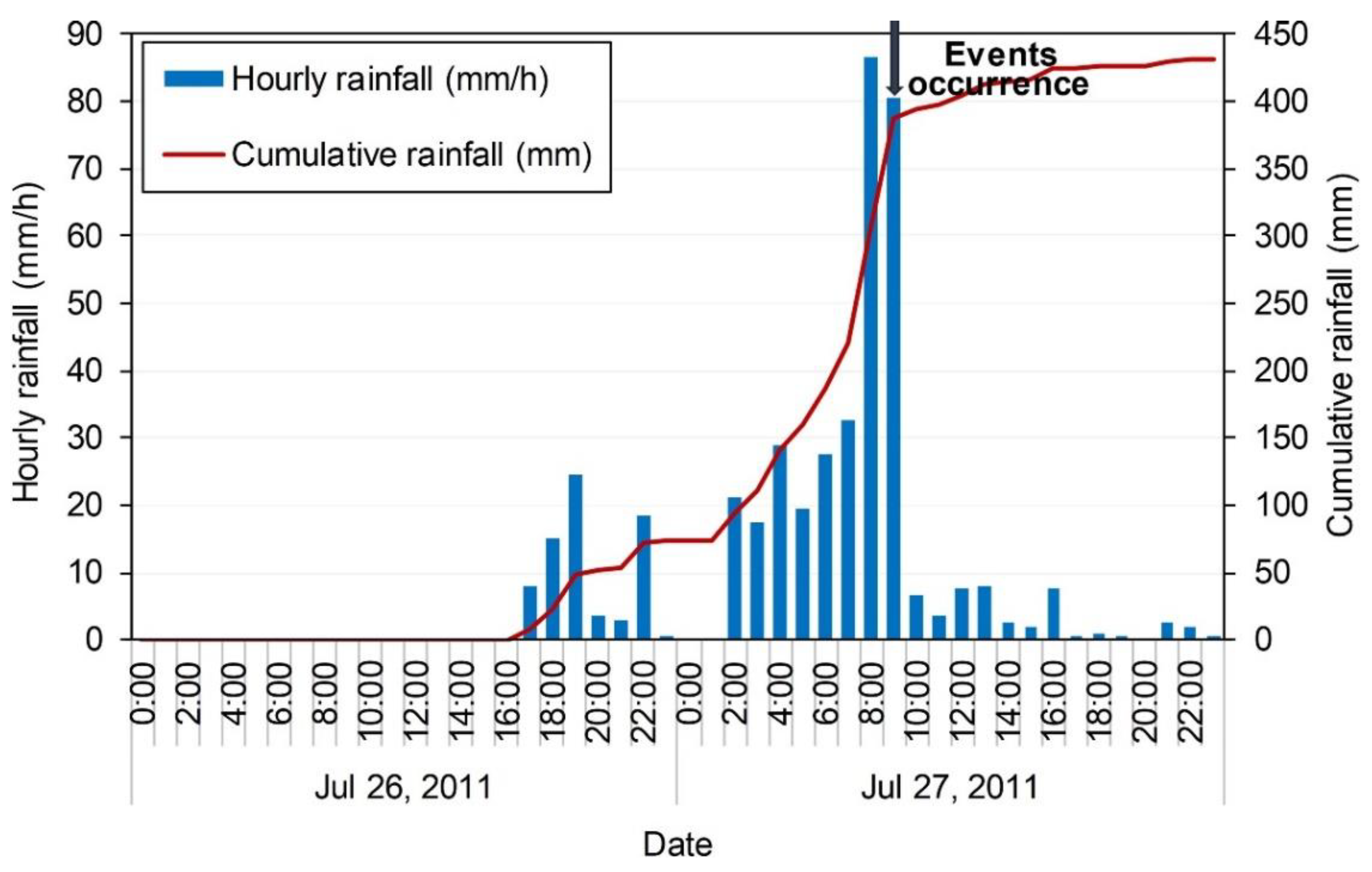

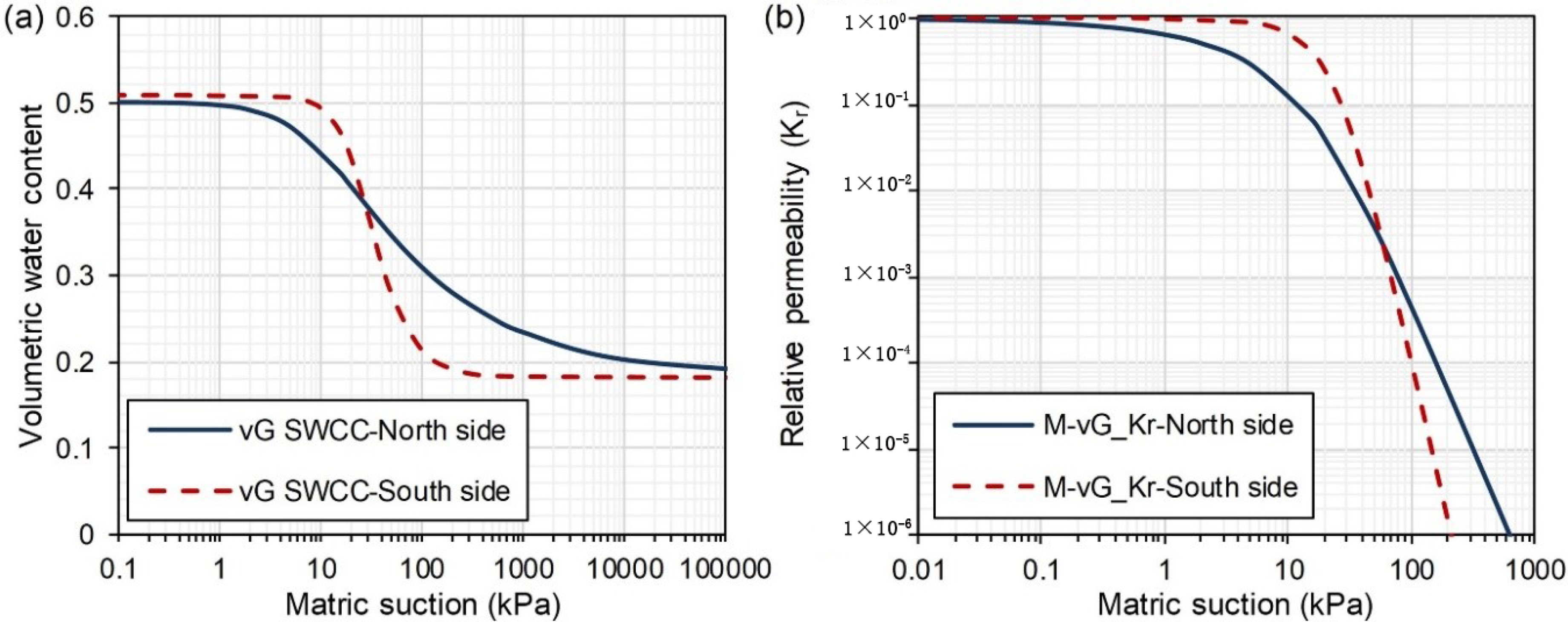
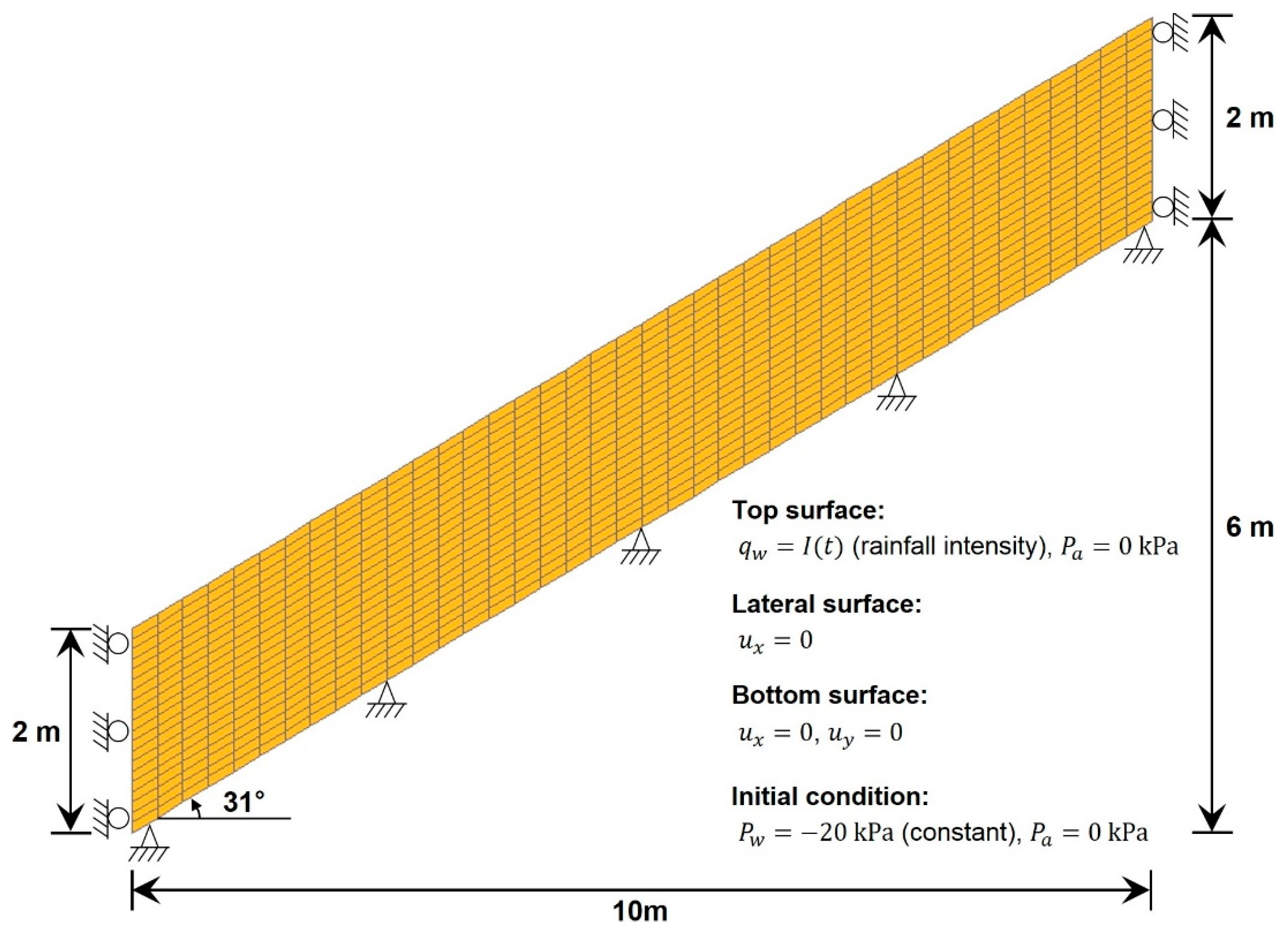
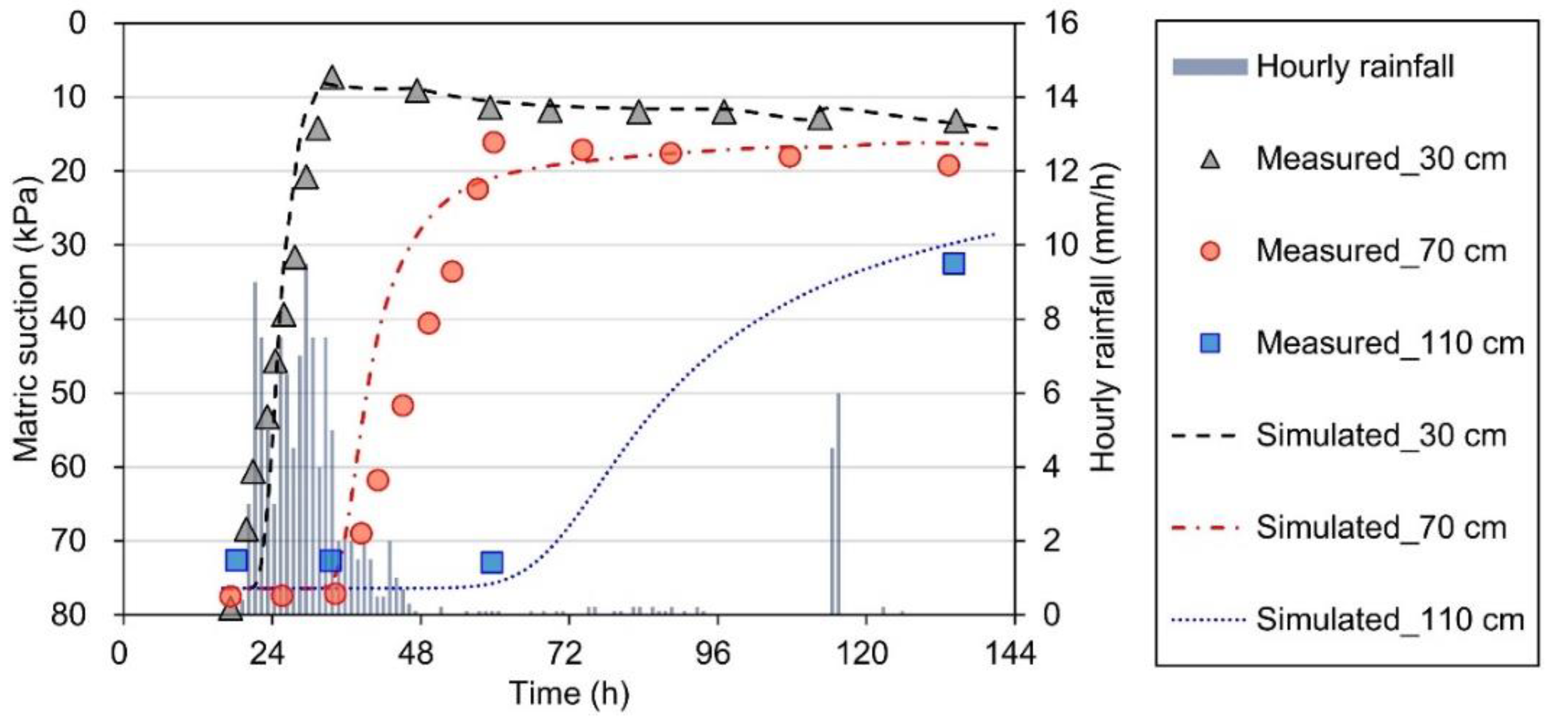
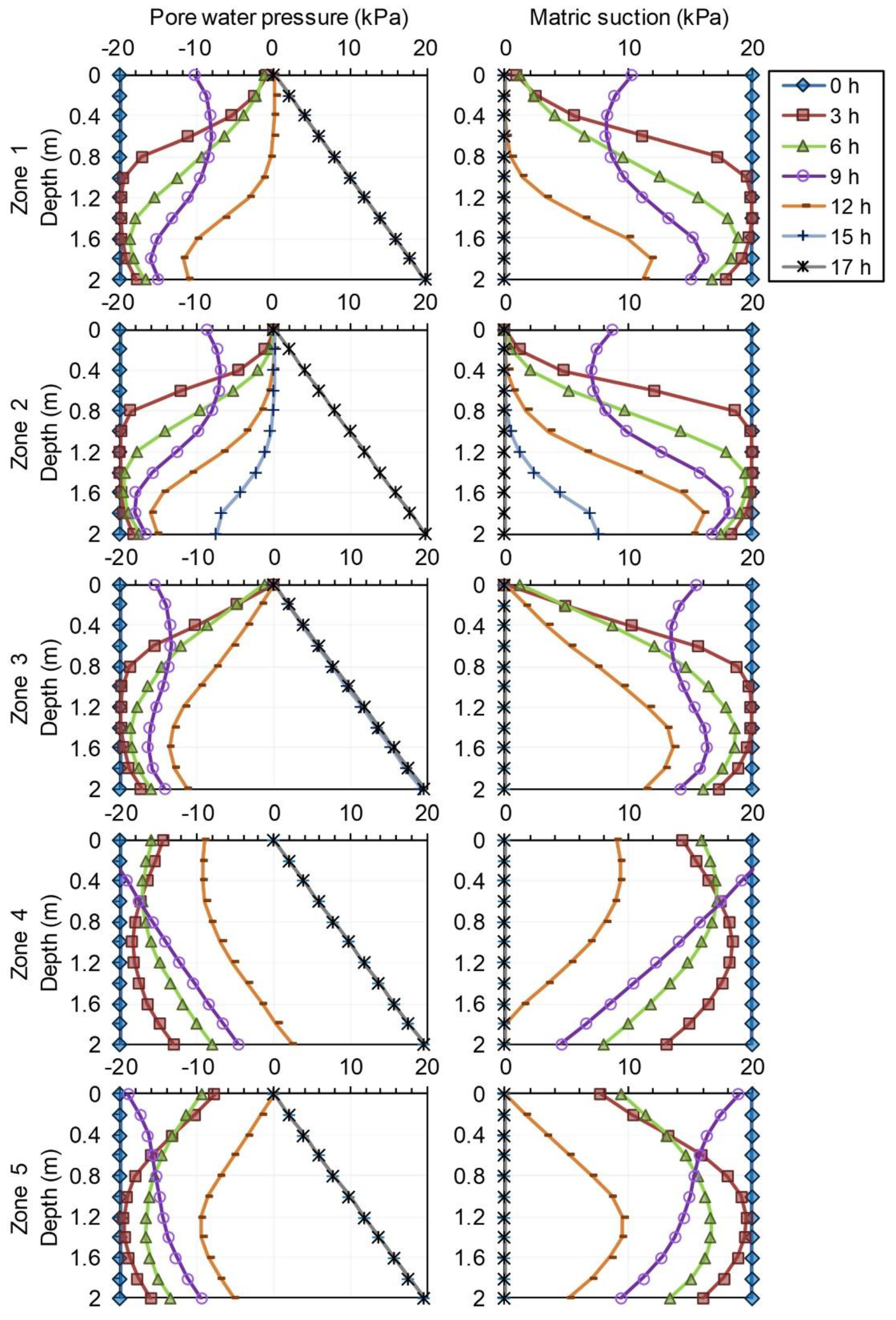
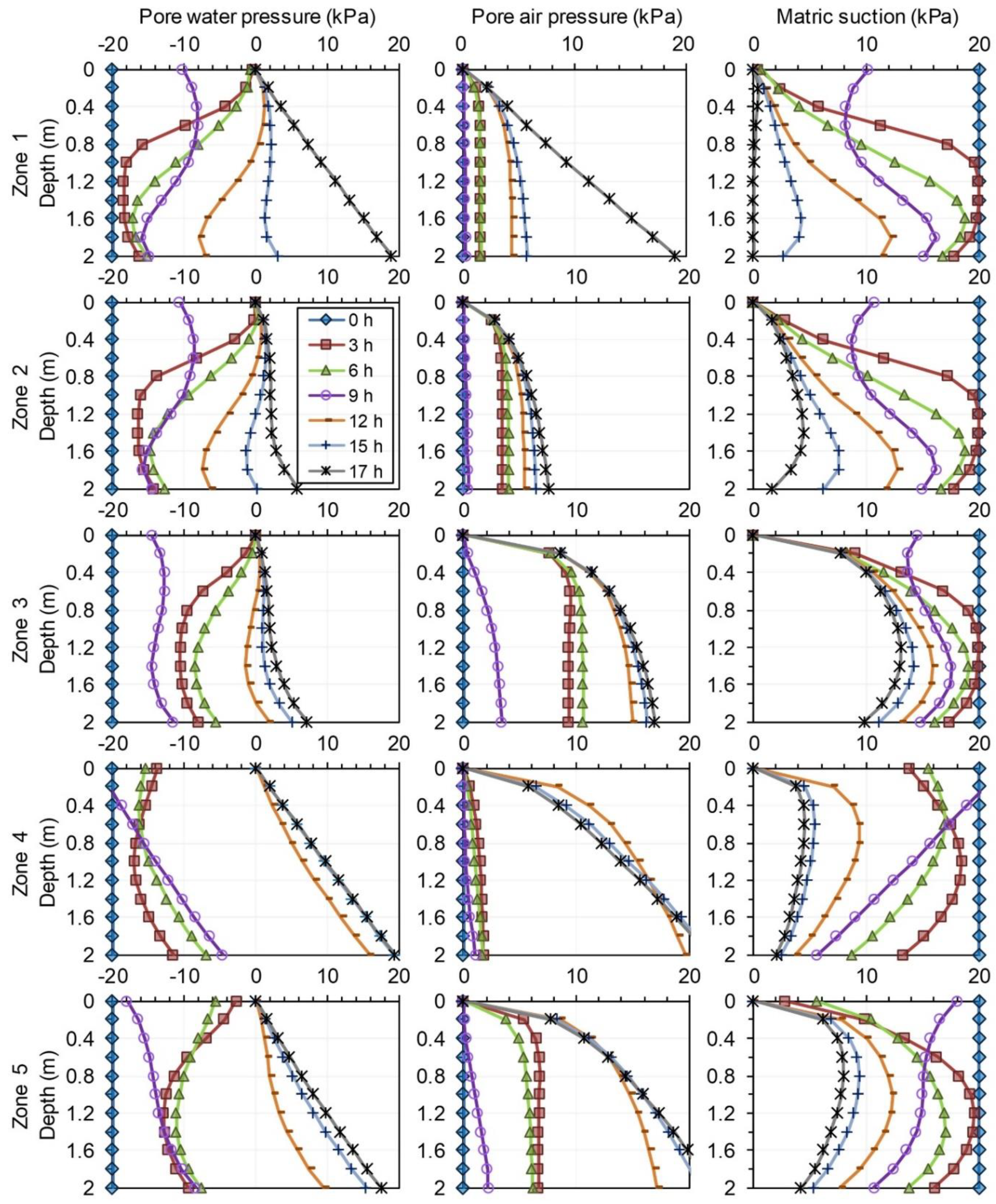
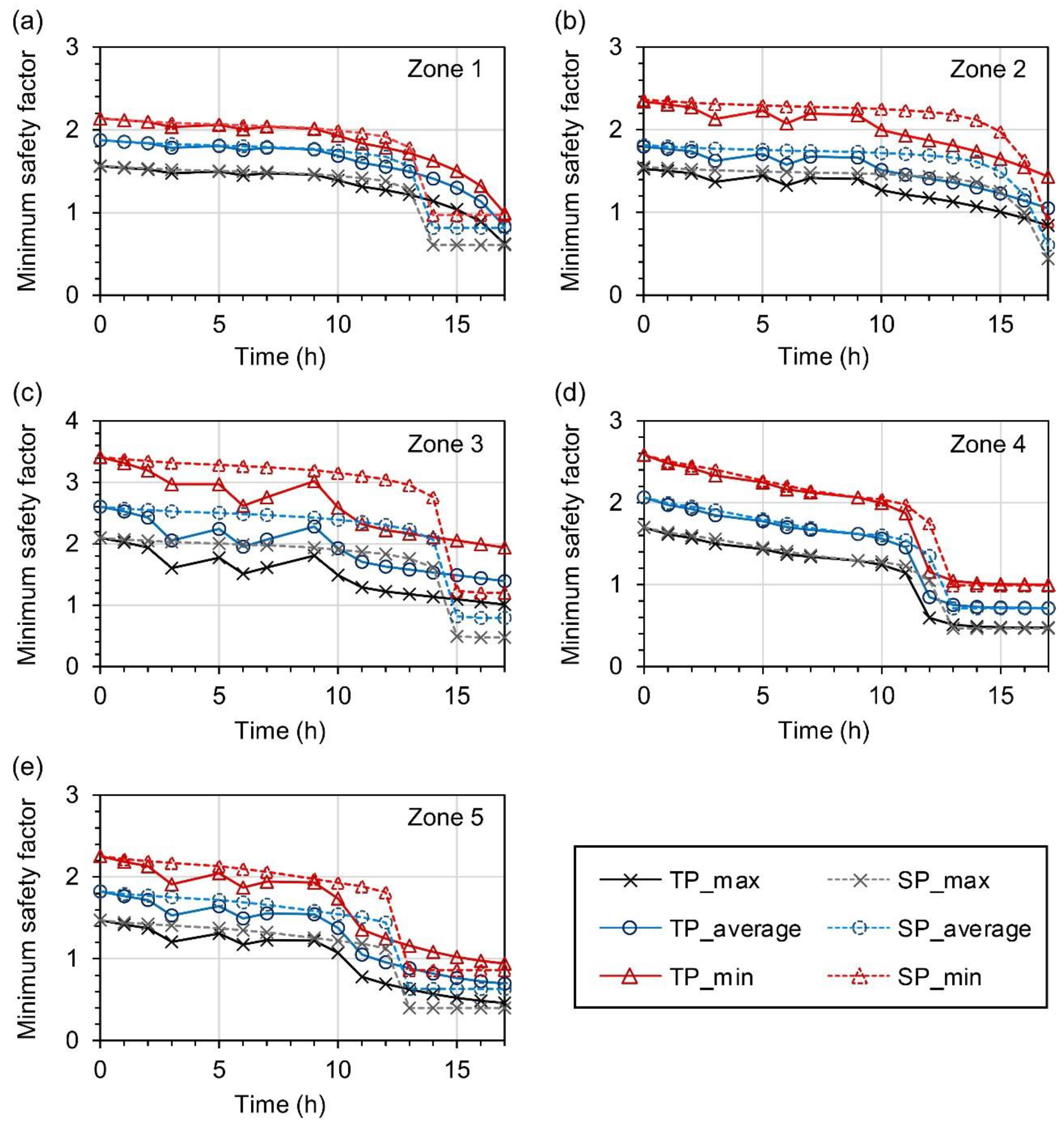
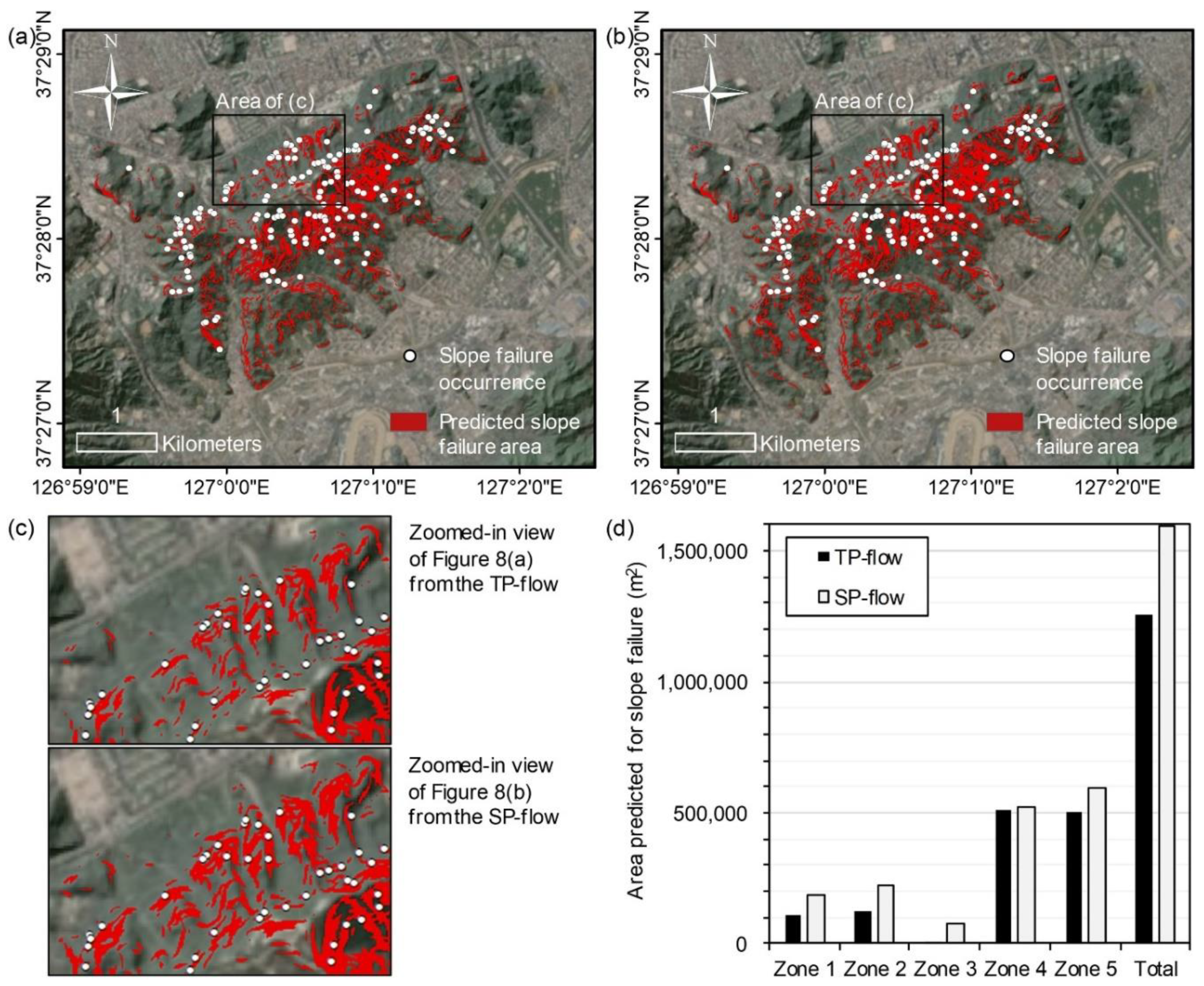
| Zone No. | (°) | c (kPa) | ks (m/s) | Van Genuchten SWCC Coefficient | |||
|---|---|---|---|---|---|---|---|
| 1/P0 | a | ||||||
| 1 | 25.3 | 9.6 | 18.1 | 15 | 7.15 × 10−6 | 0.051 | 0.35 |
| 2 | 28.5 | 5.8 | 17.7 | 14.9 | 3.87 × 10−6 | 0.051 | 0.35 |
| 3 | 37.6 | 7.7 | 17 | 14 | 1.80 × 10−6 | 0.038 | 0.63 |
| 4 | 30.9 | 7.6 | 17.3 | 14.5 | 9.70 × 10−6 | 0.038 | 0.63 |
| 5 | 28.2 | 6.3 | 18.2 | 15 | 3.69 × 10−6 | 0.038 | 0.63 |
| Parameter | Value |
|---|---|
| Viscosity ratio, | 56 |
| Water density, | 1000 kg/m3 |
| Air density, | 1.25 kg/m3 |
| Bulk modulus of water, Kw | 2 × 109 Pa |
| Bulk modulus of air, Ka | 1 × 105 Pa |
| Total Probability (Total Cells: 63,157) | TP-Flow Actual (Observed) Class | SP-Flow Actual (Observed) Class | |||
|---|---|---|---|---|---|
| Positive | Negative | Positive | Negative | ||
| Predicted class | Positive | True positive 148 (0.23%) | False positive 12,498 (19.79%) | True positive 150 (0.24%) | False positive 15,913 (25.2%) |
| Negative | False negative 13 (0.02%) | True negative 50,498 (79.96%) | False negative 11 (0.02%) | True negative 47,083 (74.55%) | |
| Efficiency (= (TP + TN)/N) | 80.19% | 74.79% | |||
| Positive predictive power (= TP/(TP + FP)) | 1.17% | 0.93% | |||
| Sensitivity (= TP/(TP + FN)) | 91.93% | 93.17% | |||
| Specificity (= TN/(FP + TN)) | 80.16% | 74.74% | |||
© 2020 by the authors. Licensee MDPI, Basel, Switzerland. This article is an open access article distributed under the terms and conditions of the Creative Commons Attribution (CC BY) license (http://creativecommons.org/licenses/by/4.0/).
Share and Cite
Kang, S.; Cho, S.-E.; Kim, B.; Go, G.-H. Effects of Two-Phase Flow of Water and Air on Shallow Slope Failures Induced by Rainfall: Insights from Slope Stability Assessment at a Regional Scale. Water 2020, 12, 812. https://doi.org/10.3390/w12030812
Kang S, Cho S-E, Kim B, Go G-H. Effects of Two-Phase Flow of Water and Air on Shallow Slope Failures Induced by Rainfall: Insights from Slope Stability Assessment at a Regional Scale. Water. 2020; 12(3):812. https://doi.org/10.3390/w12030812
Chicago/Turabian StyleKang, Sinhang, Sung-Eun Cho, Byungmin Kim, and Gyu-Hyun Go. 2020. "Effects of Two-Phase Flow of Water and Air on Shallow Slope Failures Induced by Rainfall: Insights from Slope Stability Assessment at a Regional Scale" Water 12, no. 3: 812. https://doi.org/10.3390/w12030812
APA StyleKang, S., Cho, S.-E., Kim, B., & Go, G.-H. (2020). Effects of Two-Phase Flow of Water and Air on Shallow Slope Failures Induced by Rainfall: Insights from Slope Stability Assessment at a Regional Scale. Water, 12(3), 812. https://doi.org/10.3390/w12030812





